PVD Coating Explained
What is PVD Technology?
What are the most common PVD Technology?

What is Cathodic Arc Evaporation?

What is Magnetron Sputtering?

What are the key benefits of PVD Technology?
Improve hardness:
Hardness of substrate surface can be increased 3 to 5 times by applying PVD coating without impairing tolerance and quality of coated parts
Increase wear resistance:
Higher hardness gives cutting tools and forming tools etc. much better protection against abrasive wear.
Increase oxidation resistance:
Oxidation resistance can be increased by adding a layer of protection coating on substrate surface.
Reduce friction:
Applied with coating on the surface of molds and forming dies, products can be released from molds and dies easily due to lower friction coefficient.
Increase productivity:
For working components, such as cutting tools, higher feed rate can be achieved by increasing wear resistance and heat resistance.
Hardness of substrate surface can be increased 3 to 5 times by applying PVD coating without impairing tolerance and quality of coated parts
Increase wear resistance:
Higher hardness gives cutting tools and forming tools etc. much better protection against abrasive wear.
Increase oxidation resistance:
Oxidation resistance can be increased by adding a layer of protection coating on substrate surface.
Reduce friction:
Applied with coating on the surface of molds and forming dies, products can be released from molds and dies easily due to lower friction coefficient.
Increase productivity:
For working components, such as cutting tools, higher feed rate can be achieved by increasing wear resistance and heat resistance.
Why Choose PVD Technology
There are two primary vacuum coating processes: chemical vapor deposition (CVD) and physical vapor deposition (PVD). The CVD method was the one most commonly used for many years though PVD is gradually taking over CVD’s popularity in vacuum coating families
Variety of Coating Options
PVD allows a wider range of suitable materials for coating, from pure metals and metal compounds to diamond-like carbon combination. All of them are applicable to the PVD vacuum coating system.
Low-Coating Temperature
PVD is operated at a relatively low temperature, from 200 C to 450 C, in a vacuum chamber. This means it can provide coating for a greater variety of materials, such as plastics, glass, ceramics, and hybrid substrate. This also means the parts can maintain their geometry and tolerances, allowing for coating of sharp cutting edges.
Green Technology
PVD is the more environment-friendly coating technology because no waste is produced before or after the cycle of PVD coating. In contrast, CVD coating will produce hydrogen choldride (HCI), which must be disposed of according to environmental regulations.
